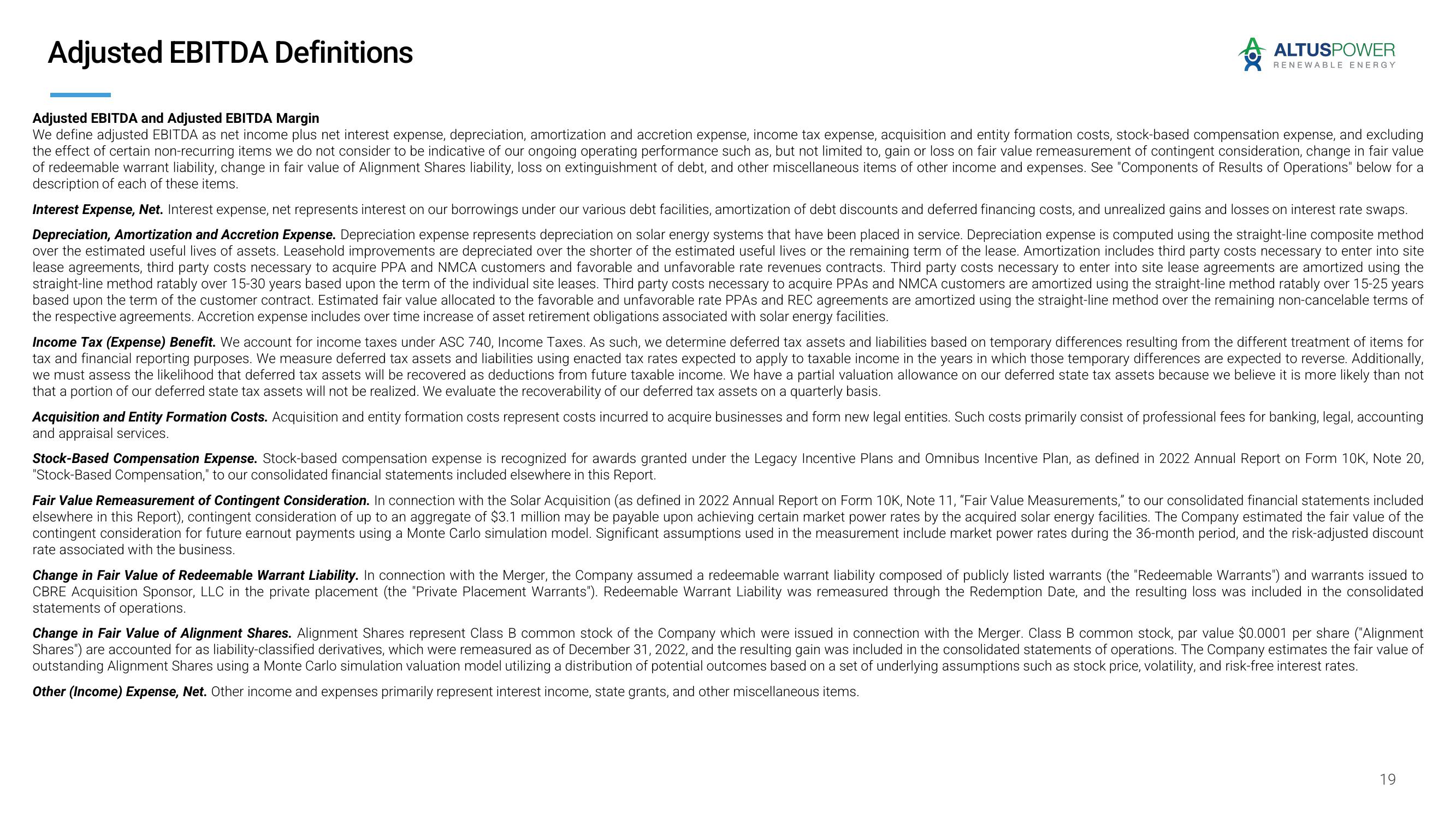Altus Power Results Presentation Deck
Adjusted EBITDA Definitions
ALTUSPOWER
RENEWABLE ENERGY
Adjusted EBITDA and Adjusted EBITDA Margin
We define adjusted EBITDA as net income plus net interest expense, depreciation, amortization and accretion expense, income tax expense, acquisition and entity formation costs, stock-based compensation expense, and excluding
the effect of certain non-recurring items we do not consider to be indicative of our ongoing operating performance such as, but not limited to, gain or loss on fair value remeasurement of contingent consideration, change in fair value
of redeemable warrant liability, change in fair value of Alignment Shares liability, loss on extinguishment of debt, and other miscellaneous items of other income and expenses. See "Components of Results of Operations" below for a
description of each of these items.
Interest Expense, Net. Interest expense, net represents interest on our borrowings under our various debt facilities, amortization of debt discounts and deferred financing costs, and unrealized gains and losses on interest rate swaps.
Depreciation, Amortization and Accretion Expense. Depreciation expense represents depreciation on solar energy systems that have been placed in service. Depreciation expense is computed using the straight-line composite method
over the estimated useful lives of assets. Leasehold improvements are depreciated over the shorter of the estimated useful lives or the remaining term of the lease. Amortization includes third party costs necessary to enter into site
lease agreements, third party costs necessary to acquire PPA and NMCA customers and favorable and unfavorable rate revenues contracts. Third party costs necessary to enter into site lease agreements are amortized using the
straight-line method ratably over 15-30 years based upon the term of the individual site leases. Third party costs necessary to acquire PPAS and NMCA customers are amortized using the straight-line method ratably over 15-25 years
based upon the term of the customer contract. Estimated fair value allocated to the favorable and unfavorable rate PPAS and REC agreements are amortized using the straight-line method over the remaining non-cancelable terms of
the respective agreements. Accretion expense includes over time increase of asset retirement obligations associated with solar energy facilities.
Income Tax (Expense) Benefit. We account for income taxes under ASC 740, Income Taxes. As such, we determine deferred tax assets and liabilities based on temporary differences resulting from the different treatment of items for
tax and financial reporting purposes. We measure deferred tax assets and liabilities using enacted tax rates expected to apply to taxable income in the years in which those temporary differences are expected to reverse. Additionally,
we must assess the likelihood that deferred tax assets will be recovered as deductions from future taxable income. We have a partial valuation allowance on our deferred state tax assets because we believe it is more likely than not
that a portion of our deferred state tax assets will not be realized. We evaluate the recoverability of our deferred tax assets on a quarterly basis.
Acquisition and Entity Formation Costs. Acquisition and entity formation costs represent costs incurred to acquire businesses and form new legal entities. Such costs primarily consist of professional fees for banking, legal, accounting
and appraisal services.
Stock-Based Compensation Expense. Stock-based compensation expense is recognized for awards granted under the Legacy Incentive Plans and Omnibus Incentive Plan, as defined in 2022 Annual Report on Form 10K, Note 20,
"Stock-Based Compensation," to our consolidated financial statements included elsewhere in this Report.
Fair Value Remeasurement of Contingent Consideration. In connection with the Solar Acquisition (as defined in 2022 Annual Report on Form 10K, Note 11, "Fair Value Measurements," to our consolidated financial statements included
elsewhere in this Report), contingent consideration of up to an aggregate of $3.1 million may be payable upon achieving certain market power rates by the acquired solar energy facilities. The Company estimated the fair value of the
contingent consideration for future earnout payments using a Monte Carlo simulation model. Significant assumptions used in the measurement include market power rates during the 36-month period, and the risk-adjusted discount
rate associated with the business.
Change in Fair Value of Redeemable Warrant Liability. In connection with the Merger, the Company assumed a redeemable warrant liability composed of publicly listed warrants (the "Redeemable Warrants") and warrants issued to
CBRE Acquisition Sponsor, LLC in the private placement (the "Private Placement Warrants"). Redeemable Warrant Liability was remeasured through the Redemption Date, and the resulting loss was included in the consolidated
statements of operations.
Change in Fair Value of Alignment Shares. Alignment Shares represent Class B common stock of the Company which were issued in connection with the Merger. Class B common stock, par value $0.0001 per share ("Alignment
Shares") are accounted for as liability-classified derivatives, which were remeasured as of December 31, 2022, and the resulting gain was included in the consolidated statements of operations. The Company estimates the fair value of
outstanding Alignment Shares using a Monte Carlo simulation valuation model utilizing a distribution of potential outcomes based on a set of underlying assumptions such as stock price, volatility, and risk-free interest rates.
Other (Income) Expense, Net. Other income and expenses primarily represent interest income, state grants, and other miscellaneous items.
19View entire presentation